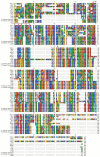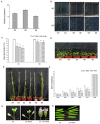How Cysteine Protease Gene PtCP5 Affects Seed Germination by Mobilizing Storage Proteins in Populus trichocarpa
- PMID: 34884443
- PMCID: PMC8657902
- DOI: 10.3390/ijms222312637
How Cysteine Protease Gene PtCP5 Affects Seed Germination by Mobilizing Storage Proteins in Populus trichocarpa
Abstract
In higher plants, seed storage proteins are deposited in protein storage vacuoles (PSVs) and degraded by protease, especially cysteine proteases, as a source of nitrogen for seed germination. In this study, a cathepsin B-like cysteine protease PtCP5, which is important for seed germination and pollen development, was first cloned in Populus trichocarpa. The GUS staining of the ProPtCP5-GUS reporter line showed that PtCP5 is expressed in the roots, stems, leaves, flowers, siliques and seeds of Arabidopsis. We reveal that PtCP5 is present in plasma membrane and co-localizes with the plasma membrane marker REM1.3. Both seed germination and early seedling development are slower in OX-PtCP5 transgenic Arabidopsis when compared with the wild-type. Further analysis revealed that, when stained with toluidine blue, the observed storage protein accumulation was lower in OX-PtCP5 than in the wild-type. Our results also show that the number of abnormal pollen grains is higher and the germination rate of pollen is lower in OX-PtCP5 than in the wild-type. These results indicate that PtCP5 is an important factor in mobilizing storage proteins and that the proper expression of PtCP5 is necessary for both pollen and seed maturation and germination. This study sheds further light on the biological functions of cysteine proteases and provides further reference for seed development research on woody plants.
Keywords: cysteine protease PtCP5; pollen; promoter; seed germination; tissue-specific expression.
Conflict of interest statement
The authors declare no conflict of interest.
Figures






Similar articles
-
Subfamily-Specific Fluorescent Probes for Cysteine Proteases Display Dynamic Protease Activities during Seed Germination.Plant Physiol. 2015 Aug;168(4):1462-75. doi: 10.1104/pp.114.254466. Epub 2015 Jun 5. Plant Physiol. 2015. PMID: 26048883 Free PMC article.
-
RRP41L, a putative core subunit of the exosome, plays an important role in seed germination and early seedling growth in Arabidopsis.Plant Physiol. 2013 Jan;161(1):165-78. doi: 10.1104/pp.112.206706. Epub 2012 Nov 6. Plant Physiol. 2013. PMID: 23132787 Free PMC article.
-
Genome-wide characterization of aspartic protease (AP) gene family in Populus trichocarpa and identification of the potential PtAPs involved in wood formation.BMC Plant Biol. 2019 Jun 24;19(1):276. doi: 10.1186/s12870-019-1865-0. BMC Plant Biol. 2019. PMID: 31234799 Free PMC article.
-
The roles of cysteine proteases and phytocystatins in development and germination of cereal seeds.J Plant Physiol. 2016 Dec 1;207:10-21. doi: 10.1016/j.jplph.2016.09.008. Epub 2016 Oct 20. J Plant Physiol. 2016. PMID: 27771502 Review.
-
Mobilization of seed protein reserves.Physiol Plant. 2012 May;145(1):140-53. doi: 10.1111/j.1399-3054.2011.01535.x. Epub 2011 Dec 1. Physiol Plant. 2012. PMID: 22017287 Review.
Cited by
-
In order to lower the antinutritional activity of serine protease inhibitors, we need to understand their role in seed development.Front Plant Sci. 2023 Oct 4;14:1252223. doi: 10.3389/fpls.2023.1252223. eCollection 2023. Front Plant Sci. 2023. PMID: 37860251 Free PMC article.
-
Identifying a cis-element in PtoCP1 promoter for efficiently controlling constitutive gene expression in Populus tomentosa.PeerJ. 2024 Oct 22;12:e18292. doi: 10.7717/peerj.18292. eCollection 2024. PeerJ. 2024. PMID: 39465144 Free PMC article.
-
Uncovering seed vigor responsive miRNA in hybrid wheat and its parents by deep sequencing.BMC Genomics. 2024 Oct 22;25(1):991. doi: 10.1186/s12864-024-10878-y. BMC Genomics. 2024. PMID: 39438825 Free PMC article.
-
A Genome Wide Association Study Revealed Key Single Nucleotide Polymorphisms/Genes Associated With Seed Germination in Gossypium hirsutum L.Front Plant Sci. 2022 Mar 16;13:844946. doi: 10.3389/fpls.2022.844946. eCollection 2022. Front Plant Sci. 2022. PMID: 35371175 Free PMC article.
References
-
- Prabucka B., Drzymała A., Grabowska A. Molecular cloning and expression analysis of the main gliadin-degrading cysteine endopeptidase EP8 from triticale. J. Cereal. Sci. 2013;58:284–289. doi: 10.1016/j.jcs.2013.06.004. - DOI
MeSH terms
Substances
Grants and funding
LinkOut - more resources
Full Text Sources

